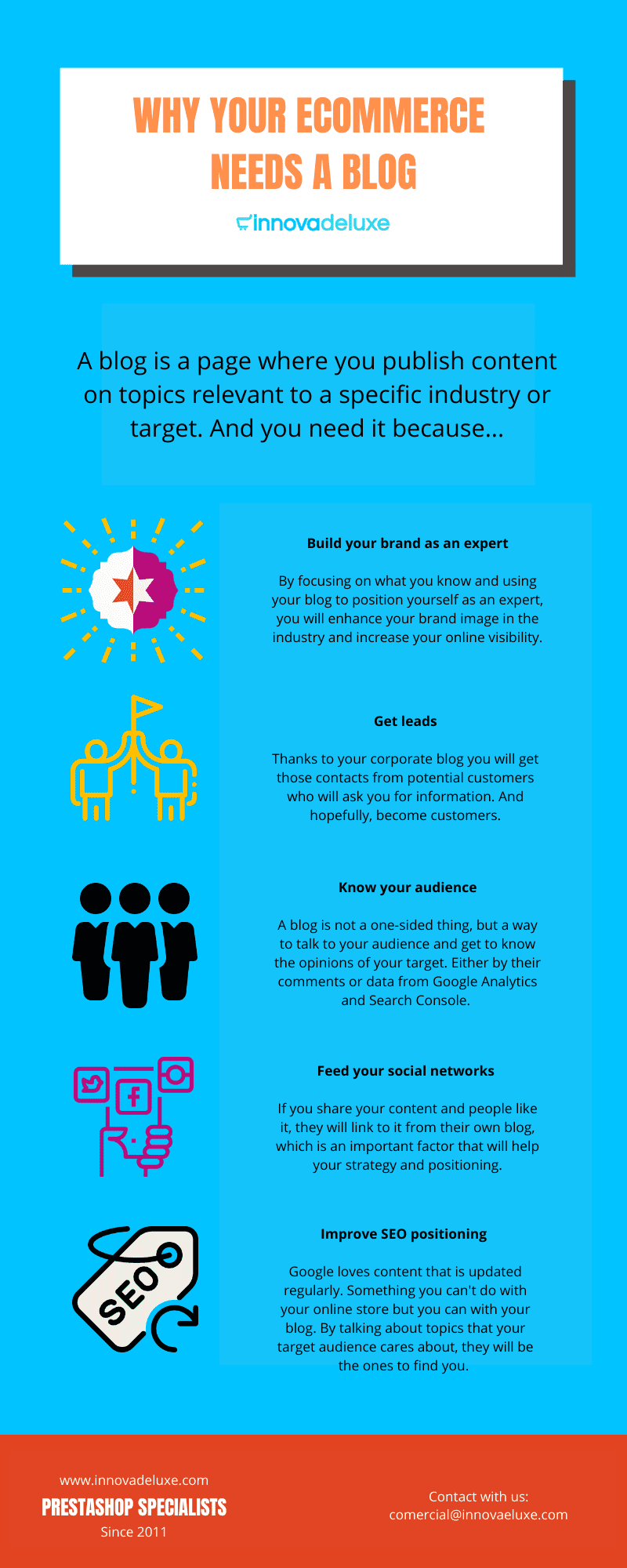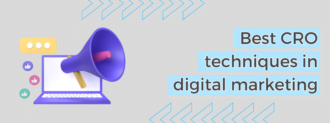If you still don’t know how important it’s to have a corporate blog in your business, take a seat, because we’re going to explain it to you in this mega guide. For starters, in case you haven’t noticed, just take a look at the Internet search results and you’ll see that for almost any information you search for, the first results you’ll see (if not all of them) are blogs. And if you pay attention, probably many of those blogs belong to companies.
Blogs had a boom long time ago that continues to this day, although it must also be said that almost all of them end up being abandoned sooner or later, because a blog requires a lot of work and perseverance. But that’s another matter.
So let’s get to the point…
Table of contents
- 1 What’s a blog?
- 2
- 3 What is a corporate blog?
- 4
- 5 Why have a corporate blog
- 5.1 Inbound marketing: to attract your target audience
- 5.2 Personality: create your own brand
- 5.3 It allows you to get to know your audience
- 5.4
- 5.5 Build customer loyalty
- 5.6 A blog feeds your Social Networks
- 5.7 Show everyone that you are an expert in your business and get leads
- 5.8
- 5.9 Improve the SEO positioning of your corporate website
- 6
- 7 What should a corporate blog have?
- 8
- 9 Creating a blog for ecommerce
- 10
- 11 8 Tips for writing in your corporate blog
- 12 Conclusion
What’s a blog?
Indeed, what do we consider a blog? It’s a website where you update content on a regular basis, talking about topics relevant to a particular sector or target.
Well, next question: how to create a blog? In the case of a personal blog, you have two options: pay for a hosting service that already includes the blog in its features. Or create a free blog, which can be fine if you don’t want to associate it with a brand. Because nothing looks worse than a blogprovidername.yourbrandname.com – this is not recommended.
If you go for a free WordPress, you won’t even have access to edit the HTML or add plugins (which in the case of WordPress is a very valuable feature). If you just want to put text and photos and not worry about anything else, fine. But forget about search engine optimization.
If you decide for a free Blogger, there you have access to the HTML of each post, and even the CSS of the theme, but the default blogger templates are terrible (sorry, but that’s how it is) You’ll have to look for a better one to install. And search engine optimization is not a panacea either.
And how does this apply to a business blog?
Whether big or small, every company must communicate with their potential clients. If the company isn’t open to its public, it’ll very difficult to gain their trust. A company blog is our little “newspaper” where we can reflect the news of our industry, our own news, provide our expertise in the form of tutorials, etc..
In the case of a company, even if you’re small, a free blog should be out of the question. The corporate blog will be an important part of your digital strategy, so you should be able to customize and optimize it, both in terms of content and SEO, to the maximum.
Because an online store requires a lot of advertising and promotion work. Basically, because people won’t find it randomly, as someone who just walk past a store in a street, so promotion is the only way to attract your audience. And for this, it’s essential to have a blog which strategy you can work together with SEO, SEM and social networks.
We’ve already given you some tips on content marketing that you can (and should) apply to your corporate blog, which will be an essential tool to position your ecommerce in search engines.
To achieve this, it’s important to write quality content on a regular basis. This dynamic content is just what Google’s algorithm likes, which interprets it as something positive, helping us to rank better. But also, users are looking for this type of content and, in the end, it will make them come to you.
What is a corporate blog?
Okay, we’ve been talking about corporate blog for companies for a while now, but what is it exactly? How is it different from a personal blog?
A personal blog gives you the freedom to talk more about whatever you want and however you want to. It can be about hobbies, travel, crochet, motorcycles, cooking… A corporate blog is closely linked to your brand, to what you want your company to represent. That is, it has to be aligned to your corporate’s philosophy.
What a corporate blog should NOT do is to talk only about your products and why people should buy them. Obviously, there’ll be some of that. But please, in a subtle way and always providing value to the user.
As we said in the first point, a corporate blog is the mirror in which all your expertise is reflected, the current affairs of the sector and even your own (although this is debatable, it will depend on whether the affairs of your company really adds value to the user).
Normally, several people are involved in the development of a corporate blog and it’s a team effort guided by a marketing plan and editorial calendar: you have to plan content beforehand!
Even if you’re a freelancer or a small company and the corporate blog is run by yourself, you still need a plan and a calendar. Don’t panic, to make it easier for you we have prepared a template to schedule your content. As each master has his own book, it’s up to you to customize it, so feel free to modify whatever you want.
Download the Content Calendar for your Corporate Blog
Ok, so we know what a corporate blog is. We already know what a corporate blog means for my company. I even have an Excel calendar to plan ahead. Is it really worth all this work?
Why have a corporate blog
Well, to answer your question, here’s a list of reasons why your company should have a corporate blog:
Inbound marketing: to attract your target audience
Online stores that have a corporate blog attract many more customers. However, you have to be able to create good content that interests your audience and allows them to make a buying decision. Your content has to position you as a reference in the sector in which you are immersed.
That is, it isn’t enough to open a blog and leave it half abandoned, uploading some content from time to time to give the impression that you work on it. You really must to work on it and above all, you need to be interested in what you write. I assure you, whoever reads it, will notice whether you are or not.
You should also give your own personality to each post you publish. Maybe you don’t have the same freedom as if it were a personal blog, which, as its name suggests, is personal and more “you”. But that doesn’t mean you can’t give it you slightly different and personal touch.
Personality: create your own brand
In this case we’re talking about an editorial brand identity, that is, the contents must always have a certain coherence with the philosophy of the company, but also with what you sell and what your audience expects. It would be strange, for example, if you’re selling mobile phones, to make a post about how healthy the Mediterranean diet is.
On the contrary, by focusing on what you know and using your blog to position yourself as an expert or company that knows a lot about your sector, you will increase your brand image, increase your online visibility and place in other people’s subconscious the idea that you know a lot about your business (and of course, this should be true, not just an idea that you place on them).
This way, when they need someone in your industry, the goal is that they’ll think of you because you have shown them that you know what you write about, which is just what they need. You’ll have earned their trust.
It allows you to get to know your audience
The company blog will be one of your communication channels, because a blog is not something unilateral, but a great way to talk to your audience and know the opinions of your target.
That’s why you should always have the comments section enabled (and moderated). Having your customer’s opinions and comments is very important, and in fact we give you a few reasons why you should have comments enabled.
And it’s not just about the comments. Even if your customers and users don’t “talk” to you directly, having Google Analytics and Search Console connected to your blog will tell you a lot about your readers.
Build customer loyalty
By giving them content of interest, you’ll make them come back to your website to read your blog. And by the way, they’ll be able to see your new products, services, offers, to which you can link from the posts or from internal advertising banners, pop ups (pop ups without going overboard), etc.
In short, you can’t make someone loyal if you don’t get them to visit you often, and you’ll get that with good content marketing on your corporate blog.
A blog feeds your Social Networks
The topic of social networks is another one. Why do I want social networks? What do I do with them? Well, one of the things you can do is to share the content of your blog.
Sharing other people’s content is fine, it’s even recommended. But if you don’t share original content that demonstrates YOUR worth and that you know what you’re talking about or selling, it’s more than likely that sooner or later you’ll start to lose followers. That’s why all the content you create on your corporate blog should be shared on the social networks associated with your business or online store.
In addition, link generation is important. That is: if you share your content and people like it, they will link to it from their own blog, or from their social networks, and that is also an important factor that will help your strategy and your SEO.
Show everyone that you are an expert in your business and get leads
Are you good at what you do? Does the rest of the world know? Do your customers know? There’s no better way to tell everyone that you control a certain sector than speaking about it in a blog. And it increases your credibility in the process.
Obviously, if you have to choose between hiring a company that you think knows what they do, and another that you have no idea of their level of knowledge (because they don’t have a corporate blog, for example), which one are you going to prefer? Thanks to your corporate blog, you’ll get those potential customer contacts (leads) that will ask you for information and probably become customers.
In addition, the company blog will humanize your brand, because the style and tone of a blog should be very close to the user/reader, rather than to a corporate website, which is often too formal. With your corporate blog you convey the feeling that behind that brand there are people, not just a company.
Improve the SEO positioning of your corporate website
The website of your company or business is a static content. Even if it’s an ecommerce, I doubt that you’re adding new categories or subcategories or lots of products every now and then.
And the visits you get throughout the day are probably not many. Or not as many as you could, because people only come to your site when they need something specific.
Because of all this, a blog within your website helps Google to ‘love’ your site more and drive more traffic to it, because Google loves content that is updated regularly. Something you can’t do with your online store.
But what do we mean when we talk about regularity? This always brings us to the million dollar question:
How often should I update the corporate blog?
Actually, this is a question that only you should answer. Because it will depend a lot on the team you have, resources, time available, and even your industry (some are more likely to have constant news and updates than others, or there are those with seasonal products and services, etc)
Our advice is to update as often as you can, but if you see that it’s not going to be possible to do it as much as you would like, it’s best to update at a constant pace. Google will “learn” how often it needs to check your blog.
You can check if your competition has a blog and how often they update it, for example. But either way, we believe that quality is always better than quantity.
What should a corporate blog have?
Once you’ve read all the advantages of having a blog, now you’ll say: that’s great, but how do you make a corporate blog? Wait. Before answering how to make a corporate blog, first we want to tell you that a corporate blog must choose well its:
- Objectives: inbound marketing, leads, create brand image…
- Strategy: determine the type of target audience, products or services to highlight…
- Planning: frequency of publication, topics, type of content…
Not the answer you were expecting, huh? Yes, of course content is important, but think that without the three previous points, the contents of your blog will be like a ship adrift. You’re going to throw them out to sea on the Internet and hopefully, they’ll reach someone worthwhile. Or not.
And now yes, if we focus more on the Content Marketing of that great company blog that you’re going to build, in that case we tell you that a corporate blog should have above all:
- Useful content for whoever is reading it. Ask yourself how that content is going to help, what doubts it solves. It must be in line with the theme of your store, and you can do it in many ways. Not just the typical post: you can make podcasts, videos, tutorials, guides, case studies, infographics…
- A good SEO work. Especially if you’re in a very competitive sector. Not everyone takes care of or works on their search engine optimization strategy. Basically because many companies don’t know how to do it and because the results are not immediate, so they don’t want to “spend money on it”. Use this situation to your advantage.
- It should always, always, always be associated with your Google Analytics and Search Console account. Otherwise, you won’t be able to measure results, which is critical: what content is performing best? What subject matter or style? At what times or days? Does it vary by city? What is the most frequent exit page? And many more questions.
Corporate blog: examples
At first, when we’re learning, we all need a light to illuminate our way. Or in this case, some examples. Apart from this our humble blog that you’re reading right now, you can look at different corporate blogs depending on your sector:
Accenture blog. It’s a clear example of a blog created for brand image (we all know how banks are perceived). The blog’s design simply says a lot about its statement of intentions. It talks about its products, but also about other topics. And when it talks about its products, it does so in a pleasant way.
Intercom Blog. This is another great example of a brand blog. At first glance, of course, you can barely find a single allusion to offers or products, you can find some topics about COVID and remote work and a lot of content useful for customer relations.
Very cool. And indeed, if you’re a brand of cool products like the Spanish Mr. Wonderful, and you play a lot with the image, then you can really talk about and sell the virtues of your products, because at the end of the day that’s what people want. And that’s what it’s all about: giving people what they want.
Adidas blog. And last but not least, a blog that works very well with content is Adidas’, as it provides you with guides, tips, etc., for runners. Who are a main part of their buyers. So if that’s not valuable content for them, then I don’t know what is.
We could go on, but the best thing to do is to look at the websites of your sector and/or competition and see what kind of blogs they have. And one thing: if they don’t already have a blog, it doesn’t mean that you shouldn’t have one. On the contrary! You take advantage of this opportunity to position yourself and take advantage of them.
Let’s keep going!
Creating a blog for ecommerce
We’ve finally gotten to the heart of the matter. And the truth is, creating a corporate blog is easier than you think. Let’s take it step by step.
On which server are you going to host your company blog?
The logical thing is to host the blog on the server where you have hosted your ecommerce, so this point is already done. We do it this way in our hosting service for both PrestaShop and WordPress.
What name to give to your blog?
If the blog is implemented within the structure of your online store as a subdomain, you don’t have to think about a domain name for it. But you do have to think about an SEO name that attracts attention, as in the example of Adidas, whose blog is called “Adidas runnastic”, since it’s focused in the world of runners.
Which platform to choose for my corporate blog?
If you have it integrated into your hosting, the most common situation is that many of them offer you the WordPress platform by default, so you have it already preinstalled on the server. It’s that easy.
How do I customize my blog?
Both visually and functionally, a WordPress blog is usually very easy to use thanks to its organized backoffice, which will allow you to customize the design in a few clicks. And in terms of functionality, WordPress has a large community of developers behind it and it’s very rare that you’ll need something that hasn’t already been created.
Once you have all these steps done, there’s only one thing left: start publishing!
8 Tips for writing in your corporate blog
Now that we’ve passed you the hot potato and we’ve left you the task of generating content for your corporate blog, we’d like to finish this article guiding you in the laborious task of filling your company’s blog according to the schedule.
Read a lot
And not just about what’s going on in your industry or in the market, but about everything. You never know where you’re going to find inspiration for an idea to put into a post.
We recommend using news aggregators like Feedly, a totally free service where you can follow the blogs and media you’re most interested in, and comfortably read all their news in one place.
Write a lot
“Don’t put off until tomorrow what you can do today”. If you have a great idea for your blog content today, write it down and try to develop it today – or if not, at least in the next few days.
If you have a person in charge of writing, pass the idea on to them immediately, even if you can’t elaborate on it at the moment, but they can do their research and think about how to structure the topic in relation to your business.
And if you’re the one writing, write it down, write it down, write it down. A notebook, a post it, the mobile, social networks, your hand… It doesn’t matter. Wherever it is, but write it down. You never know when you might need it.
Add value
It’s important to provide value, to provide information to your user, potential customer or current customer that makes them think about things. For example, this post: Do you really need a blog or not? Are you going to be able to do it? What do you need to get it?
In the case of an ecommerce, you can provide tips about your products, advantages, uses that maybe the customer hadn’t thought of, etc. You’ll know how to do this better than anyone else, since you’re the one who knows your product and your market.
Be original
Look for unique, original content. Depending on the sector of your ecommerce, you won’t always be able to look for “cool” content that no one is talking about, because in the end, trends and customer needs are the ones that rule.
But even if it’s about a popular topic, tell it from a different perspective or at least give it your personal touch. It can be in the tone of the post, the way it’s laid out, the type of image you use as a header, that you always include an infographic with a very characteristic look… you chose!
Above all, simplicity
Even if you’re an expert, don’t overdo it. Technical terms and other “words” typical of your sector or your work should be used sparingly, and if you have the slightest doubt that someone doesn’t understand them, explain them briefly.
Obviously, if it’s a B2B blog (from business to business) you can relax more with this issue. But if it’s B2C, as most of them are (i.e. business to customer), don’t overwhelm with being technical, you don’t need to.
Writing like an expert is not incompatible with using colloquial expressions. The formal but close tone generates a lot of sympathy among readers, who perceive that the author is a “normal” person.
Structure your posts well
It’s normal that your blog posts follow a structure and a visual image, determined by the template and CSS you’re using, respectively. Even so, each content requires a certain way of being told.
Be clear about the internal structure: headers, whether to use lists or not, where to place the images, etc. Remember that many of your users (probably most of them) access your content via mobile, and you should make your posts pleasant and easy to read.
Spend time on the blog
When we say spend time blogging, we’re not just talking about writing. If everything is well planned and organized, and you know what you’re talking about, that’s about as easy as it gets. Some posts will take more time and some will take less. Simply put.
We’re mostly talking about the planning stage, the researching of topics, keywords, trends, reliable sources, etc. Don’t just sit down and write. Make a list, put it in order, whatever. But plan, and then everything will come out by itself.
Don’t get obsessed with visits
Obviously, visits have their importance, but especially at the beginning, you should not let them condition you too much. Everything takes time, and positioning yourself in search engines so that more people besides your clients find you, will probably take some time.
But don’t give up! Be patient. Trust your content and give it a chance. Don’t discard it at the first down. Sometimes it takes a while to get the style you want to come across.
Check in Google Analytics and Search Console what works and what doesn’t, improve what has potential, and wait a bit before discarding anything.
Conclusion
And having said all this, are you up for it?
From Innovadeluxe we can help you create your blog for your ecommerce: we help you to install templates or even make you a custom one and mount it on your company blog along with your online store.
We also take care of your Content Marketing, making a study of the keywords of your business and writing the posts for your blog. You can ask us without compromise.
In any case, we hope we’ve made you understand the importance of having a corporate blog for your ecommerce or company. And so that you don’t forget everything we’ve talked about, we share with you this infographic that you can save to remember it.

And to finish this topic, we encourage you to generate a community around your brand and thus gradually increase sales and relevance in the network of your online store!
Do you want to know more, do you need help, don’t hesitate to leave us a comment!
Related Posts




















Deja un comentario